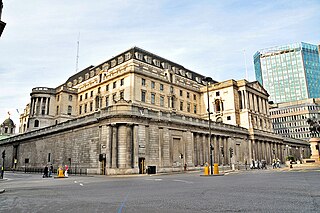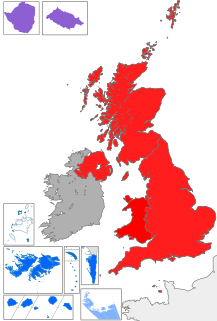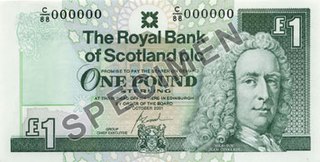
The Bank of England is the central bank of the United Kingdom and the model on which most modern central banks have been based. Established in 1694 to act as the English Government's banker, and still one of the bankers for the Government of the United Kingdom, it is the world's eighth-oldest bank. It was privately owned by stockholders from its foundation in 1694 until it was nationalised in 1946 by the Attlee ministry.
Legal tender is a form of money that courts of law are required to recognize as satisfactory payment for any monetary debt. Each jurisdiction determines what is legal tender, but essentially it is anything which when offered ("tendered") in payment of a debt extinguishes the debt. There is no obligation on the creditor to accept the tendered payment, but the act of tendering the payment in legal tender discharges the debt.

Sterling banknotes are the banknotes in circulation in the United Kingdom and its related territories, denominated in pounds sterling.

The Bank of Scotland plc is a commercial and clearing bank based in Scotland and is part of the Lloyds Banking Group, following the Bank of Scotland's implosion in 2008.

Clydesdale Bank,, is a trading name used by Clydesdale Bank plc for its retail banking operations in Scotland.

Lloyds Bank plc is a British retail and commercial bank with branches across England and Wales. It has traditionally been considered one of the "Big Four" clearing banks. Lloyds Bank is the largest retail bank in Britain, and has an extensive network of branches and ATMs in England and Wales and offers 24-hour telephone and online banking services. As of 2012 it had 16 million personal customers and small business accounts.
AIB (NI) is a commercial bank in Northern Ireland that is part of Allied Irish Banks's UK subsidiary AIB Group (UK) plc. It is one of the Big Four banks in Ireland. The bank was created in 1991 when TSB Northern Ireland merged with the AIB Group's other interests. The bank can trace its existence back to 1816 with the founding of the Belfast Savings Bank. The bank was one of the four banks that issued Pound Sterling banknotes in Northern Ireland until February 2019; First Trust notes are still in circulation. Allied Irish Banks confirmed plans to sell off the bank in April 2010 as part of plans to raise capital, however these plans were subsequently shelved and instead the bank announced investment plans starting in 2014. The bank traded as First Trust Bank in Northern Ireland until November 2019.
The pound is the currency of Guernsey. Since 1921, Guernsey has been in currency union with the United Kingdom and the Guernsey pound is not a separate currency but is a local issue of banknotes and coins denominated in pound sterling, in a similar way to the banknotes issued in Scotland, England and Northern Ireland. It can be exchanged at par with other sterling coinage and notes.
The Gibraltar pound is the currency of Gibraltar. It is pegged to – and exchangeable with – the British pound sterling at par value. Coins and banknotes of the Gibraltar pound are minted or printed by the Government of Gibraltar.
The Manx pound is the currency of the Isle of Man, in parity with the pound sterling. The Manx pound is divided into 100 pence. Notes and coins, denominated in pounds and pence, are issued by the Isle of Man Government.
Banknotes have been issued for use specifically in Northern Ireland since 1929, and are denominated in pounds sterling. They are legal currency, but technically not legal tender anywhere. This is not uncommon as most bank notes are not recognised as tender. However, the banknotes are still widely accepted as currency by larger merchants and institutions elsewhere in the United Kingdom. Issuing banks have been granted legal rights to issue currency, and back the notes with deposits at the Bank of England.
The Bank Charter Act 1844, sometimes referred to as the Peel Banking Act of 1844, was an Act of the Parliament of the United Kingdom, passed under the government of Robert Peel, which restricted the powers of British banks and gave exclusive note-issuing powers to the central Bank of England. It is one of the Bank of England Acts 1694 to 1892.

Waterlow and Sons Limited was a major worldwide engraver of currency, postage stamps, stocks and bond certificates based in London, Watford and Dunstable in England. The company was founded as a family business in 1810. It was acquired in 1961 by De La Rue.

The Bank of England, which is now the central bank of the United Kingdom, British Crown Dependencies and British Overseas Territories, has issued banknotes since 1694. In 1921 the Bank of England gained a legal monopoly on the issue of banknotes in England and Wales, a process that started with the Bank Charter Act of 1844 when the ability of other banks to issue notes was restricted.
Banknotes of Scotland are the banknotes of the pound sterling that are issued by three Scottish retail banks and in circulation in Scotland. The issuing of banknotes by retail banks in Scotland is subject to the Banking Act 2009, which repealed all earlier legislation under which banknote issuance was regulated, and the Scottish and Northern Ireland Banknote Regulations 2009. Currently, three retail banks are allowed to print notes for circulation in Scotland: Bank of Scotland, Royal Bank of Scotland, and Clydesdale Bank.

Tone Dale House is a Grade II listed country house built in 1801 or 1807 by Thomas Fox in Wellington, Somerset, England. Wellington lies 7 miles (11 km) west of Taunton in the vale of Taunton Deane, 1 mile (1.6 km) from the Devon border. Tone Dale House, also known as House of Fox, offers views of Somerset which include the Quantock hills to the north and the Blackdown Hills to the south.

The Bank of Scotland £5 note, also known informally as a fiver, is a banknote of the pound sterling. It is the smallest denomination of banknote issued by the Bank of Scotland. The current polymer note, first issued in October 2016, bears the image of Sir Walter Scott on the obverse and a vignette of the Brig o' Doon on the reverse. The polymer replaces a cotton note also featuring a portrait of Sir Walter Scott.
The Bank of Scotland £50 note is a banknote of the pound sterling. It is the second largest of five banknote denominations issued by the Bank of Scotland. The current polymer note, first issued in 2021 bears the image of Walter Scott on the obverse and a vignette of the Falkirk Wheel and The Kelpies on the reverse.

The Royal Bank of Scotland £1 note is a banknote of the pound sterling. The current cotton note, first issued in 1987 bears an image of Lord Ilay, one of the founders of the bank, on the obverse and a vignette of Edinburgh Castle on the reverse.
The Bank of England £100,000,000 note, also referred to as Titan, is a non-circulating Bank of England banknote of the pound sterling used to back the value of Scottish and Northern Irish banknotes. It is the highest denomination of banknote printed by the Bank of England. As both of these regions have their own currency issued by particular local banks, the non-circulating notes provide the essential link between those currencies and that of England, and security if a local issuing bank were to fail.










